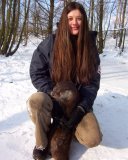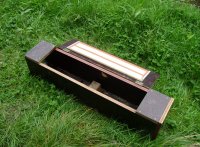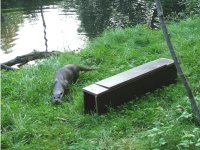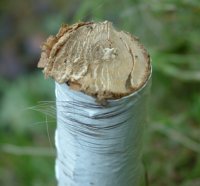IUCN/SSC Otter Specialist Group Bulletin

|
IUCN/SCC Otter Specialist Group Bulletin Volume 27 Issue 2 Pages 59 - 122 (June 2010) Citation: Kuhn, R.A. (2010). Note on Hair-Sampling Devices for Eurasian Otters. IUCN Otter Spec. Group Bull. 27 (2): 98 - 104 Note on Hair-Sampling Devices for Eurasian Otters 1Aktion Fischotterschutz e.V., OTTER-ZENTRUM, 29386 Hankensbüttel, Germany, e-mail:rachelkuhn@yahoo.fr |
 |
|
Abstract:Devices to collect hairs from Eurasian otters were tested in captivity. Two designs of hair traps (a wooden box and a set of 7 sticks stuck into the ground) were set in an enclosure and each was tested with two different materials to capture hairs: double-sided adhesive tape and the hook side of velcro brand fastener. Three types of lures were used to entice the otters into the box: food, foreign spraints and cod liver oil. All the hair trap configurations tested were successful in capturing hairs, and up to 52 hairs/24 hours were found glued on the adhesive tape that was fastened to the lid of the box. The set of sticks with velcro strips was the less effective device with only 5 hairs captured in 4 days. |
| Keywords:hair trap, hair catcher, hair snagging |
| Française | Español |
INTRODUCTION
Hair traps are used to collect hairs from wild animals for species identification using hair structure, DNA-based analysis or toxicology studies (e.g. Baker et al., 2003; Foran et al., 1997; Woods et al., 1999). Hair sampling devices have the advantages of being non-invasive and do not need to be visited routinely as necessary for traps. Various designs using different materials to snag hairs (glue, tape, wire, brushes etc.) have been presented and used in previous studies (e.g. Suckling, 1978; Baker, 1980; Major, 1991; Pasitschniak-Arts and Messier, 1995; Mowat and Strobeck, 2000; Mills et al., 2002; Mowat and Paetkau, 2002). The animals are generally attracted to the trap using lures, for example food or odorous substances like faeces, urine or beaver castoreum (e.g. Nelson, 1979; McDaniel et al., 2000).
Only few researchers have tried to capture hairs from otters using hair traps (Busserolles and Mercier, 2004; Depue and Ben-David, 2007). The semi-aquatic way of life of these species makes such experiments particularly difficult. In this study, the efficiency of four hair trap configurations (two designs, each with two different materials to capture hairs) was tested on Eurasian otters, Lutra lutra (Linnaeus, 1758) in captivity.
MATERIALS AND METHODS
The hair traps were tested during summer in an exhibit enclosure with 3 adult males at the Otter-Centre (OTTER-ZENTRUM) in Hankensbüttel (Germany).
The first hair-sampling device tested was a wooden box (20x20x100 cm; Figure 1). The box had one entrance (20x20 cm) on the side (in previous trials with a box opened at both ends, forming a sort of tube, the otters used to put their head into the box but did not go through it). The material to capture hairs was attached to a removable board (60x15 cm) that was fastened to the lid of the box (74 cm). In one configuration double-sided adhesive tape was used and in the other one the material to capture hairs was the hook side of velcro brand fastener. A wooden block (6x8 cm) was screwed on the bottom of the box, in order to make the otters arch their back and brush against the adhesive tape/velcro when reaching the back of the box (previous trials without the wooden block had shown that the otters went into the box but did not touch the sticky surface with their back).
 |
| Figure
1. Wooden box with double sided adhesive tape on
a removable board (click for larger image) |
Testing of the box with adhesive tape was conducted during 6 days. The otters were attracted to the trap using three different lures, each during 48 hours: 1. food (chicks), 2. spraints from two males living in other enclosures, 3. cod liver oil. The box was checked and the board replaced by a new one daily (food was renewed in trial 1). The box with velcro strips fastened on the removable board was tested during 24 hours, baited with chicks.
In another trial, 7 wooden sticks were set along the trail between one of the sleeping boxes and the water (Figure 2). The sticks were from 15 to 25 cm high (distance above the ground). The distance between the sticks was from 20 to 40 cm, and the distance between the first and the last stick was 110 cm. In one configuration double-sided adhesive tape was wrapped around the stick. A modification of the trap was to fasten velcro strips to the sticks (Figure 3). These hair catchers were controlled after 4 days and then again a week later.
 |
 |
| Figure 2. Sticks with adhesive tape (click for larger image) | Figure 3. Stick with a velcro strip |
RESULTS
All the hair trap configurations were successful in collecting hairs, mainly guard (primary) hairs. Up to 52 guard hairs/24 h could be collected using the wooden box with adhesive tape (Figure 4). Table 1 shows the number of guard hairs collected with the different lures. The hairs could be removed easily with forceps. The box with velcro strips enabled us to catch 22 guard hairs per 24 hours.
 |
| Figure 4. Otter approaching the box (click for larger image) |
|
|
|||
| Table 1: Number of guard hairs collected with adhesive tape fastened to the lid of the wooden box for each lure | |||
|
|
|||
| Food | Spraints | Cod Liver Oil | |
| Day 1 |
52 |
24 |
8 |
| Day 2 |
44 |
0 |
0 |
|
|
|||
The sticky sticks enabled us to collect 50 guard hairs (on 3 sticks) in 4 days (Figure 5). One week later, only two more guard hairs were glued on one of the sticks. The tape had lost almost all its adhesion. Only 5 guard hairs (all on one stick) could be collected by the velcro strips (all during the first 4 days). The sticks were quite dirty and marked with spraints at the end of the trial, showing that the otters visited the trap but had not left many hairs.

|
| Figure 5. Sticky stick with captured hairs |
DISCUSSION AND CONCLUSION
In previous studies, Busserolles and Mercier (2004) could collect hairs from Lutra lutra in captivity using pieces of coco doormats set along trails or rolling places. Depue and Ben-David (2007) captured hairs from Lontra canadensis in the wild with 2 traps, a modified body-snare and a modified foot-hold trap, set on river banks, along the coast of otter latrine sites, crossover points and trails.
The hair sampling devices tested in this study appeared to be effective in captivity. The hair-collecting box seems to be the easiest way to capture hairs because otters brush against the material to capture hairs (adhesive tape/velcro) each time they enter the box and again when they step back to leave the box. However, it is difficult to predict the efficacy of this device in the wild because it may be much more complicated to entice wild otters into the box. Food may not be an effective lure for otters in the wild and anyway the food would have to be enclosed within a wire mesh chamber or similar device, in order not to be eaten by the first “visitor” that would probably not be an otter. Only few hairs could be collected with cod liver oil, which means that this bait induced few visits by the otters living in the enclosure (maybe only one visit). Better results were obtained with spraints. Spraints are particularly interesting lures because they appear to be effective in attracting foreign otters (Rosoux pers. comm. in Libois et al. 1990; Kellermann 1998, this study), they decompose slowly and are normally not eaten or stolen. Traditional lures used by hunters like valerian and camphor are ineffective in attracting otters (Kellermann, 1998). Depue and Ben-David (2007) did use a commercial otter lure at latrine sites but did not specify if this increased the efficacy of their traps.
The sticks with double-sided adhesive tape also showed good capture efficiency and may be less repellent than the box for a wild otter. They could be set along trails or at sprainting sites. Further trials in captivity and in the wild may be useful to find out the optimum number and disposition of the sticks. The system could be improved by the use of lures (for example foreign spraints). The sticks with velcro strips did not show satisfactory results with only 5 guard hairs captured in 4 days. It would be worth to do further trials with some modifications (for example the velcro strips could be wrapped around the sticks).
Generally, the double-sided adhesive tape appeared to be a better material to capture hairs than the velcro strips, especially if it is necessary to obtain the root. It is recommended to choose a tape with a strong adhesion, which stays sticky at least several days despite of humidity. Pocock and Jennings (2006) used the sticky substance Faunagoo, which lasts a lot longer than sticky tape. However, the velcro strips at the lid of the wooden box enabled us to collect 22 guard hairs within a day, which is a quite satisfying result. Velcro strips may be particularly interesting if the hairs have to be used for toxicology analyses, since in this case an interaction with chemical glue may bias the results. In regard of the fact that Eurasian otters moult gradually throughout the year (Kuhn, 2009; Kuhn et al., 2010), there is no season that is particularly advantageous for hair collection.
In conclusion, the results of the tests in captivity were satisfying, but the hair-sampling devices now have to be tested in the wild.
Acknowledgements - Special recognition must be given to the German Otter-Centre (OTTER-ZENTRUM) and Association for Otter Conservation (Aktion Fischotterschutz), particularly to Jens Kietzmann who constructed the hair-sampling box. I gratefully acknowledge the financial support of the German Otter Foundation (Deutsche Otter Stiftung). Many thanks go to Laurent Mercier who has sent me the unpublished results of his work on hair traps with Fanny de Busserolles. A specific acknowledgement is directed at Prof. Dr. Wilfried Meyer (Institute for Anatomy, University of Veterinary Medicine, Hannover) for having corrected the manuscript. In memory of the late Claus Reuther who initiated this project.
REFERENCES
Baker, E.W. (1980). Hair-catchers aid in identifying mammalian predators of ground nesting birds. Wildl. Soc. Bull. 8: 257-259.
Baker, P.J., Ansell, R.J., Dodds, P.A., Weber, C.E., Harris, S. (2003). Factors affecting the distribution of small mammals in an urban area. Mammal. Rev. 33: 95-100.
Busserolles, F. De, Mercier, L. (2004). Etude de la faisabilité de pièges à poils sur la Loutre d’Europe Lutra lutra (Linné, 1758). Centre de Réintroduction des Cigognes et des Loutres de Hunawihr. Unpublished.
Depue, J.E., Ben-David, M. (2007). Hair Sampling Techniques for River Otters. J. Wildl. Manage. 7: 671-674.
Foran, D.S., Crooks, K.C., Minta, S.C. (1997). DNA-based analysis of hair to identify species and individuals for population research and monitoring. Wildl. Soc. Bull. 25: 840-847.
Kellermann, K. (1998). Geruchstest beim europäischen Fischotter (Lutra lutra Linné, 1758). Praktikumsbericht, OTTER-ZENTRUM, Hankensbüttel. Unpublished.
Kuhn, R.A. (2009). Comparative analysis of structural and functional hair coat characteristics, including heat loss regulation, in the Lutrinae (Carnivora: Mustelidae). PhD Thesis, University of Hamburg, Hamburg, Germany.
Kuhn, R.A., Ansorge, H., Godynicki, S., Meyer, W. (2010). Hair density in the Eurasian otter Lutra lutra and the Sea otter Enhydra lutris. Acta theriol. 55 (in press).
Libois, R.M., Paquot, A., Lambert, M. (1990). Des pièges olfactifs pour détecter la présence de la Loutre (Lutra lutra) ? Cahiers Ethol. 10:105-110.
Major, R.E. (1991). Identification of nest predators by photography, dummy eggs, and adhesive tape. Auk108: 190-195.
McDaniel, G.W., McKelvey, K.S., Squires, J.R., Ruggiero, L.F. (2000). Efficacy of lures and hair snares to detect Lynx. Wildl. Soc. Bull. 28: 119-123.
Mills, D.J., Harris, B., Claridge, A.W., Barry, S.C. (2002). Efficacy of hair-sampling techniques for the detection of medium-sized terrestrial mammals. I. A comparison between hair-funnels, hair tubes and indirect signs. Wildl. Res. 29: 379-387.
Mowat, G., Paetkau, D. (2002). Estimating marten population size using hair capture and genetic tagging in southeast British Columbia. Wildl. Biol. 8: 201-209.
Mowat, G., Strobeck, C. (2000). Estimating population size of Grizzly Bears using hair capture, DNA profiling and mark-recapture analysis. J. Wildl. Manage. 64: 183-193.
Nelson, K.A. (1979). The occurrence of wolverine (Gulo luscus) and other mammals by baited hair traps and snow transects in Six Rivers National Forest. Technical Report. Six Rivers National Forest, Eureka, CA.
Pasitschniak-Arts, M., Messier, F. (1995). Predator identification at simulated waterfowl nests using inconspicuous hair catchers and wax-filled eggs. Can. J. Zool. 73: 984-990.
Pocock, M.J.O., Jennings, N. (2006). Use of hair tubes to survey for shrews: new methods for identification and quantification of abundance. Mammal Rev. 36: 299-308.
Suckling, G.C. (1978). A hair sampling tube for the detection of small mammals in trees. Aust. Wildl. Res. 5: 249-252.
Woods, J.G., Paetkau, D., Lewis, D., McLellan, B.N., Proctor, M., Strobek, C. (1999). Genetic tagging of free ranging black and brown bears. Wildl. Soc. Bull. 27: 616-627.
Résumé : Note sur les Methodes de Capture de Poils de Loutre d’Europe
Des systèmes pour prélever des poils de loutres d’Europe furent testés en captivité. Deux modèles (une caisse en bois et une série de 7 bâtons plantés dans le sol) furent placés dans un enclos et chacun fut testé avec deux types de matériaux pour collecter les poils : du ruban adhésif double face et la couche crochet d’une bande auto-agrippante velcro. Trois types d’appâts furent utilisés pour inciter les loutres à entrer dans la caisse : de la nourriture, des épreintes étrangères et de l’huile de foie de morue. Tous les pièges à poils testés furent efficaces et jusqu’à 52 poils/24 heures furent retrouvés collés sur le ruban adhésif fixé au couvercle de la caisse. La série de bâtons avec des bandes velcro fut le système le moins efficace, avec seulement 5 poils collectés en 4 jours.
Revenez au dessus
Resumen: Nota sobre los Equipos para Muestreo de Pelos de Nutria Eurasiatica
Equipos para el muestreo de pelos de nutria euroasiatica fueron provados en captividad. Dos diseños de tranpas de pelos (una caja de madera y siete estacas plantadas en el suelo) fueron dispuestos entre un cerco; cada uno fue probado con dos materiales diferentes para capturar los pelos: cinta adhesiva de doble cara y la superficie engancharte de una cinta de velcro. Se utilizaron tres tipos de señuelos para atraer las nutrias: alimento, excrementos y aceite de hígado de bacalado. Todas las trampas fueron exitosas en muestrear pelos, hasta 52 pelos / 24 horas fueron hallados en la cinta adhesiva adherida a la tapa de la caja de madera. Las estacas con velcro fueron menos efectivas con solamente 5 pelos en 4 días.
Vuelva a la tapa